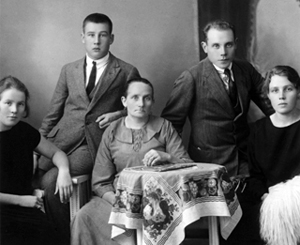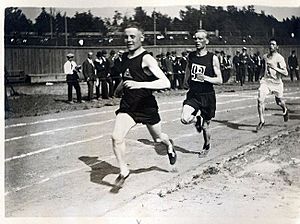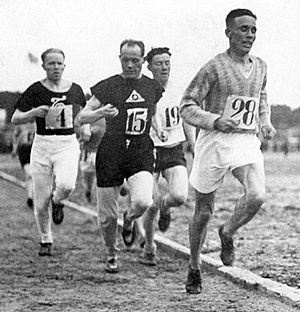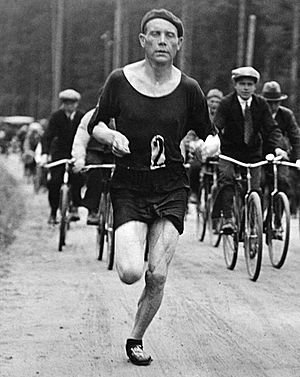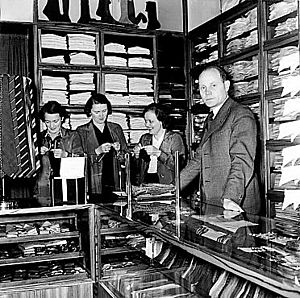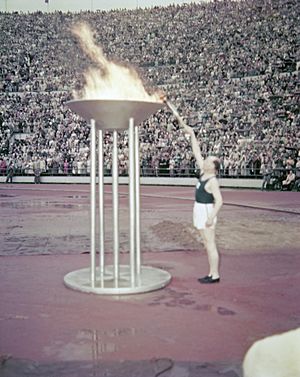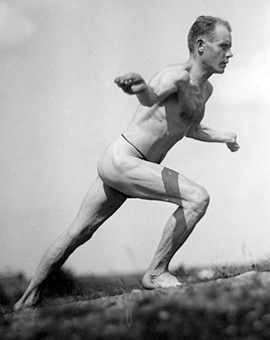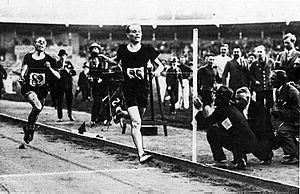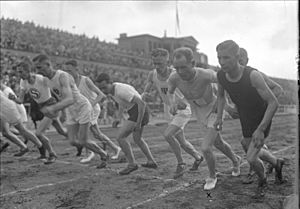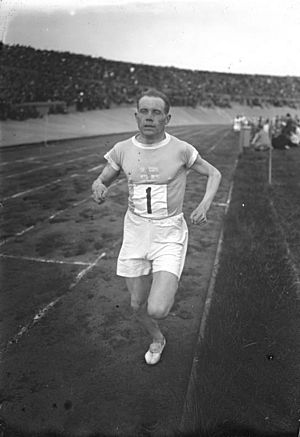Paavo Nurmi facts for kids
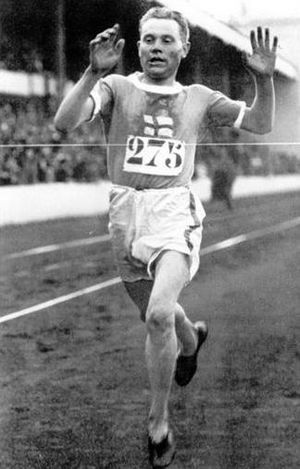
Nurmi at the 1920 Summer Olympics
|
||||||||||||||||||||||||||||||||||||||||||||
| Personal information | ||||||||||||||||||||||||||||||||||||||||||||
|---|---|---|---|---|---|---|---|---|---|---|---|---|---|---|---|---|---|---|---|---|---|---|---|---|---|---|---|---|---|---|---|---|---|---|---|---|---|---|---|---|---|---|---|---|
| Full name | Paavo Johannes Nurmi | |||||||||||||||||||||||||||||||||||||||||||
| Born | 13 June 1897 Turku, Finland |
|||||||||||||||||||||||||||||||||||||||||||
| Died | 2 October 1973 (aged 76) Helsinki, Finland |
|||||||||||||||||||||||||||||||||||||||||||
| Height | 174 cm | |||||||||||||||||||||||||||||||||||||||||||
| Weight | 65 kg | |||||||||||||||||||||||||||||||||||||||||||
| Sport | ||||||||||||||||||||||||||||||||||||||||||||
| Country | Finland | |||||||||||||||||||||||||||||||||||||||||||
| Sport | Athletics | |||||||||||||||||||||||||||||||||||||||||||
|
Medal record
|
||||||||||||||||||||||||||||||||||||||||||||
Paavo Johannes Nurmi (born June 13, 1897 – died October 2, 1973) was a famous Finnish runner. He was known for running middle and long distances. People called him the "Flying Finn" because he was so fast and dominant in the 1920s.
Nurmi set 22 official world records in races from 1500 meters to 20 kilometers. He won an amazing nine gold and three silver medals at the Olympic Games. At his best, Nurmi won 121 races in a row! He was never beaten in cross country races or the 10,000 meters during his 14-year career.
Nurmi came from a working-class family. He left school at age 12 to help his family. In 1912, he was inspired by another Finnish runner, Hannes Kolehmainen, and started a very strict training plan. He became a top runner during his time in the military. He made his international debut at the 1920 Summer Olympics.
At the 1920 Olympics, he won a silver medal in the 5000 meters. Then, he won gold in the 10,000 meters and both cross country events. In 1923, Nurmi became the first runner ever to hold world records at the same time for the mile, 5000 meters, and 10,000 meters. No one has done this since!
At the 1924 Summer Olympics, he set new world records for the 1500 meters and 5000 meters. He did this with only an hour between the races. He won gold medals in both events in less than two hours. Even with a heat wave in Paris, Nurmi won all his races. He came home with five gold medals. He was a bit upset because Finnish officials didn't let him run the 10,000 meters.
After a tough tour in the U.S. in 1925, Nurmi faced strong rivals like Ville Ritola and Edvin Wide. At the 1928 Summer Olympics, Nurmi won the 10,000 meters again. But he took silver in the 5000 meters and the 3000 meters steeplechase. He then started focusing on even longer distances. He broke world records for events like the one hour run. Nurmi wanted to end his career with a marathon gold medal, just like his hero Kolehmainen.
However, a big problem came up before the 1932 Games. The IAAF (the international athletics group) suspended Nurmi. They questioned if he was still an amateur runner. Two days before the Olympics, they stopped him from competing. Even though he was never officially called a professional, his suspension became final in 1934. He then retired from running.
Later, Nurmi coached Finnish runners. He also helped raise money for Finland during the Winter War. He became a successful businessman, working as a clothing seller, builder, and stock trader. He became one of the richest people in Finland. In 1952, he had the honor of lighting the Olympic Flame at the Summer Olympics in Helsinki.
Nurmi's speed and quiet personality earned him nicknames like the "Phantom Finn." His achievements and training methods inspired many runners who came after him. He often ran with a stopwatch in his hand. He is known for creating the "even pace" strategy. This means running at a steady speed throughout the race. He also helped make running a major sport around the world.
Contents
Early Life and Training
Paavo Nurmi was born in Turku, Finland. His father, Johan Fredrik Nurmi, was a carpenter. His mother was Matilda Wilhelmiina Laine. Paavo had four younger siblings. In 1903, his family moved to a small apartment in central Turku. Paavo lived there until 1932.
When he was young, Nurmi and his friends were inspired by English runner Alfred Shrubb. They often ran or walked six kilometers to swim in Ruissalo, sometimes twice a day. By age eleven, Nurmi could run 1500 meters in 5 minutes and 2 seconds.
His father died in 1910, and his sister Lahja died a year later. His family faced money problems. Nurmi, who was a good student, left school to work for a bakery. He pushed heavy carts up steep hills in Turku. He later said these climbs made his back and leg muscles strong.
At 15, Nurmi became interested in running again. He was inspired by Hannes Kolehmainen, who had done amazing things at the 1912 Summer Olympics. Nurmi bought his first running shoes soon after. He trained by running cross country in summer and skiing in winter.
In 1914, Nurmi joined the Turun Urheiluliitto sports club. He won his first race, a 3000-meter event. Two years later, he changed his training. He added walking, sprints, and body exercises. He continued to work to support his family. In April 1919, he started his military service. During the Finnish Civil War in 1918, Nurmi focused on his work and his Olympic dreams.
In the army, Nurmi quickly showed his talent in sports. While others marched, he ran with a rifle and a backpack full of sand. Nurmi was very determined. His unit commander, Hugo Österman, liked sports. So, Nurmi and other athletes were given time to practice.
Nurmi invented new ways to train in the army. He ran behind trains, holding onto the back, to make his stride longer. He also used heavy army boots to make his legs stronger. Soon, Nurmi was setting personal bests and getting ready for the Olympics. In March 1920, he became a corporal. On May 29, 1920, he set his first national record in the 3000 meters. In July, he won the 1500 meters and 5000 meters at the Olympic trials.
Olympic Achievements
Antwerp 1920 and Paris 1924
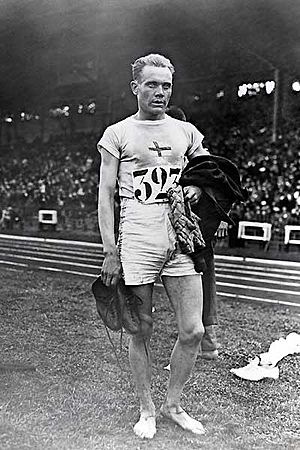
Nurmi first competed internationally at the 1920 Summer Olympics in Antwerp, Belgium. He won his first medal, a silver, in the 5000 meters. He finished second to Joseph Guillemot of France. This was the only time Nurmi lost to a non-Finnish runner at the Olympics.
He then won three gold medals. He won the 10,000 meters, passing Guillemot on the last turn. He also won the individual cross country race and the team cross country event. His success helped his family get electricity and running water at home. Nurmi also received a scholarship to study engineering in Helsinki.
After losing to Guillemot, Nurmi started to experiment with his running. He used a stopwatch to keep an even pace. He wanted to make his technique so perfect that his rivals' efforts wouldn't matter. In 1921, he set his first world record in the 10,000 meters. In 1922, he broke world records for the 2000 meters, 3000 meters, and 5000 meters. A year later, he added records for the 1500 meters and the mile. No other athlete has ever held the world records for the mile, 5000 meters, and 10,000 meters at the same time. Nurmi also tested his speed in the 800 meters, winning the Finnish Championships in 1923. He graduated as an engineer in 1923.
Nurmi's trip to the 1924 Summer Olympics was almost stopped by a knee injury. But he recovered and trained twice a day. On June 19, he practiced the Olympic schedule in Helsinki. He ran the 1500 meters and 5000 meters within an hour, setting new world records for both.
In the 1500 meters final in Paris, Nurmi ran very fast at the start. His only challenger gave up. Nurmi slowed down but still broke the Olympic record. The 5000 meters final started less than two hours later. Nurmi faced a tough challenge from his countryman Ville Ritola. Ritola and Edvin Wide thought Nurmi would be tired. They tried to run at a world-record pace. Nurmi threw his stopwatch aside and raced them. The Finns passed the Swede, and Nurmi won by a small margin.
In the cross country races, the weather was extremely hot (45 °C or 113 °F). Most of the 38 runners had to quit. Nurmi showed only slight tiredness after beating Ritola by almost a minute and a half. Finland also won the team gold medal. The heat was so bad that Olympic officials decided to ban cross country running from future Games.
The next day, in the 3000 meters team race, Nurmi and Ritola finished first and second. This helped the Finnish team win another gold medal. Nurmi won five gold medals in five events. But he was disappointed because Finnish officials had not let him run the 10,000 meters. After returning to Finland, Nurmi set a 10,000-meter world record that lasted for almost 13 years. He now held world records for the 1500 meters, mile, 3000 meters, 5000 meters, and 10,000 meters all at once.
U.S. Tour and Amsterdam 1928
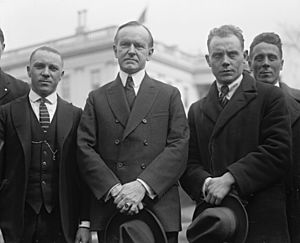
In early 1925, Nurmi went on a famous tour of the United States. He competed in 55 races over five months. He won 51 of these events. His tour made him very popular in the U.S. He even met President Calvin Coolidge at the White House. Nurmi worried that he had raced too much and might be tired out.
Nurmi found it hard to stay motivated for running. He also had some health issues. In 1926, he quit his job and started studying business. He began a new career as a stock dealer. In 1926, Nurmi broke the 3000-meter world record twice. In October 1926, he lost a 1500-meter race and his world record to Otto Peltzer of Germany. This was his first defeat in over five years in a race longer than 1000 meters.
At the 1928 Olympic trials, Nurmi finished third in the 1500 meters. He decided to focus on longer distances. He also added the steeplechase to his events, even though he had only tried it twice before.
At the 1928 Olympics in Amsterdam, Nurmi competed in three events. He won the 10,000 meters by staying behind Ritola and then sprinting past him. Before the 5000 meters final, Nurmi hurt himself in a steeplechase heat. He fell and sprained his hip and foot. In the 5000 meters, Nurmi tried to beat Ritola again but couldn't. He looked very tired and barely managed to keep Wide behind him, taking silver.
Nurmi had little time to rest because the 3000 meters steeplechase started the next day. He struggled with the hurdles. He finished nine seconds behind the winner, Toivo Loukola, but his time was still faster than the old world record. Finland won all three medals in this event.
Focus on Longer Distances
Nurmi told a Swedish newspaper that 1928 would be his last season. He felt he was getting old after 15 years of racing. However, Nurmi kept running, focusing on even longer distances. In October, he broke world records for the 15 km, 10 miles, and the one hour run. His one-hour record lasted for 17 years.
In 1929, Nurmi started his second U.S. tour. He lost a mile race, which was his first defeat in that event. People wondered if the mile was now too short for him. In 1930, he set a new world record for the 20 km. In July 1931, Nurmi showed he could still run fast in shorter races. He broke the world record for the two miles, becoming the first runner to finish it in under nine minutes. Nurmi planned to only compete in the 10,000 meters and the marathon at the 1932 Summer Olympics in Los Angeles.
In April 1932, the International Amateur Athletics Federation (IAAF) suspended Nurmi. They wanted to investigate if he was still an amateur runner. The Finnish Athletics Federation said the IAAF acted without a proper hearing. But they agreed to investigate. A week later, the Finnish federation found no proof that Nurmi was a professional. Nurmi hoped his suspension would be lifted for the Games.
On June 26, 1932, Nurmi ran his first marathon at the Olympic trials. He ran 40.2 km (25 miles) in 2 hours, 22 minutes, and 3.8 seconds. This was a new unofficial world record for that distance. He stopped the race early because of an Achilles tendon problem. The Finnish Olympic Committee entered Nurmi for both the 10,000 meters and the marathon. Nurmi trained in Los Angeles despite his injury. He really wanted to end his career with a marathon gold medal, like Kolehmainen.
1932 Olympics and Retirement
Just before the 10,000 meters race, the IAAF commission stopped Nurmi from competing in Los Angeles. This decision caused a lot of anger in Finland. Thousands of people protested in Helsinki. The IAAF claimed Nurmi had received money for races in Germany.
On the day before the marathon, all the other runners signed a petition asking for Nurmi to be allowed to compete. But Finland insisted that Nurmi should be allowed to run officially, not just outside the competition. Even though he had an injury, Nurmi said he would have won the marathon easily. The IAAF congress did not declare Nurmi a professional, but they upheld the council's power to ban athletes.
Nurmi refused to become a professional runner. He continued to run as an amateur in Finland. In 1933, he won the national 1500 meters title. In August 1934, the IAAF made Nurmi's suspension from international amateur athletics permanent. Less than three weeks later, Nurmi retired from running. His last race was a 10,000-meter victory in Viipuri on September 16, 1934. Nurmi was never defeated in the 10,000 meters during his 14-year career. His winning streak in cross country running lasted 19 years.
Later Life and Legacy
When he was a runner, Nurmi kept his training methods a secret. He always ran alone. After he retired, Nurmi became a coach for the Finnish Athletics Federation. He trained runners for the 1936 Summer Olympics. In 1936, Nurmi also opened a men's clothing store in Helsinki. It became a popular place for tourists. He also started a construction business, building many apartment buildings. He became a millionaire within five years. Nurmi also made money in the stock market, becoming one of Finland's richest people.
In February 1940, during the Winter War between Finland and the Soviet Union, Nurmi went to the United States. He went with his student Taisto Mäki to raise money and support for Finland. They toured the country. Former President Herbert Hoover called them "ambassadors of the greatest sporting nation in the world." Nurmi later served in the Continuation War in Finland.
In 1952, Nurmi was asked to carry the Olympic torch into the Olympic Stadium at the 1952 Summer Olympics in Helsinki. His appearance surprised everyone. People cheered loudly. After lighting the flame in the main cauldron, Nurmi passed the torch to his hero Kolehmainen.
Nurmi felt he got too much credit as an athlete and not enough as a businessman. But he always loved running. He even ran a few times after retiring. In 1962, Nurmi predicted that rich countries would struggle in distance running. He warned young people not to let comfortable lives make them lazy. He wanted them to stay active. Nurmi lived to see Finnish running become strong again in the 1970s.
Nurmi lived a very private life until the late 1960s. He then started giving some interviews. On his 70th birthday, he agreed to an interview only if the President of Finland, Urho Kekkonen, was the interviewer. Nurmi had health problems later in life. He sometimes spoke sadly about sports, saying it was a waste of time compared to science and art. He died in 1973 in Helsinki and had a state funeral.
Personal Life and Public Image
Nurmi was married to Sylvi Laaksonen from 1932 to 1935. They had a son named Matti. Sylvi did not want their son to be a runner. Matti Nurmi did become a middle-distance runner and a successful businessman. His relationship with his father was sometimes difficult. Matti admired his father more as a businessman than as an athlete.
Nurmi enjoyed Finnish sports massages and sauna bathing. He said the Finnish sauna helped him perform well in the heat at the 1924 Paris Olympics. He ate a varied diet, but he was a vegetarian from age 15 to 21.
Nurmi was known for being quiet and determined. He was not thought to have many close friends. But he sometimes socialized and showed a "sarcastic sense of humor" with people he knew well. Even though he was the biggest sports star in the world, Nurmi didn't like publicity. He once said that "worldly fame and reputation are worth less than a rotten lingonberry."
Some people called him Suuri vaikenija (The Great Silent One). Runner Ron Clarke said Nurmi was a mystery even to Finnish runners and journalists. He seemed like a "god in a cloud."
Nurmi was more open with other athletes than with the media. He shared ideas with sprinter Charley Paddock and even trained with his rival Otto Peltzer. Nurmi told Peltzer to focus on himself: "Conquering yourself is the greatest challenge of an athlete." Nurmi believed that mental strength was key: "Mind is everything; muscle, pieces of rubber. All that I am, I am because of my mind."
Because he often ran with a stopwatch, the press called him a "running machine." One newspaper called him "a mechanical Frankenstein created to annihilate time." People even rumored that he had a "freakish heart" with a very slow pulse.
Nurmi's Impact
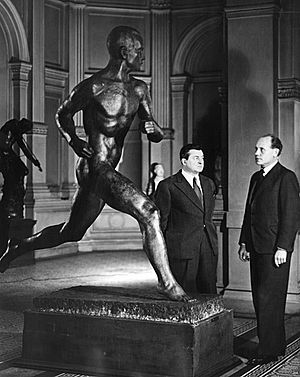
Nurmi broke 22 official world records in distances from 1500 meters to 20 kilometers. This is a record in running. He also set many unofficial records. His record for most Olympic gold medals was later matched by gymnast Larisa Latynina, swimmer Mark Spitz, and runner Carl Lewis. Swimmer Michael Phelps broke it in 2008. Nurmi's record for most Olympic medals lasted until 1960. Time magazine called Nurmi the greatest Olympian of all time in 1996.
Nurmi introduced the "even pace" strategy to running. He used a stopwatch to keep a steady speed throughout the race. He believed that if you race against time, you don't need to sprint at the end. Others can't keep up if the pace is steady and hard. He was also a pioneer in training. He created a year-round training program that included long-distance running and interval running.
Nurmi's achievements and training methods inspired many future running stars. Emil Zátopek used to chant "I am Nurmi! I am Nurmi!" when he trained as a child. Lasse Virén looked up to Nurmi. Hicham El Guerrouj was inspired to run by stories of Nurmi. He became the first man since Nurmi to win both the 1500 meters and 5000 meters at the same Olympics.
A bronze statue of Nurmi was made in 1925 by Wäinö Aaltonen. Copies of this statue are in Turku, Jyväskylä, in front of the Helsinki Olympic Stadium, and at the Olympic Museum in Lausanne, Switzerland. In 1939, Finnish astronomer Yrjö Väisälä named an asteroid 1740 Paavo Nurmi after him. Finnair named its first DC-8 plane Paavo Nurmi in 1969.
The Paavo Nurmi Marathon is held every year in Wisconsin, USA. Another marathon with his name is held in his hometown of Turku, Finland, since 1992. The Paavo Nurmi Stadium in Turku was named after him in 1997. Many world records have been set there. In 1987, a ten-mark bill with Nurmi's picture was issued by the Bank of Finland.
Career Summary (1920–34)
Seasons
| Season | Distances | Starts | Wins | Podiums | DNF |
|---|---|---|---|---|---|
| 1920 | 1500 m – 10,000 m | 14 | 13 | 14 | 0 |
| 1921 | 800 m – 10,000 m | 17 | 15 | 16 | 0 |
| 1922 | 800 m – 4 miles | 20 | 20 | 20 | 0 |
| 1923 | 800 m – 5000 m | 23 | 23 | 23 | 0 |
| 1924 | 800 m – 10,000 m | 25 | 25 | 25 | 0 |
| 1925 | 800 m – 10,000 m | 58 | 56 | 57 | 1 |
| 1926 | 1000 m – 10,000 m | 19 | 16 | 19 | 0 |
| 1927 | 1500 m – 5000 m | 12 | 12 | 12 | 0 |
| 1928 | 1500 m – One hour run | 15 | 12 | 15 | 0 |
| 1929 | Mile – 6 miles | 14 | 12 | 14 | 0 |
| 1930 | 1500 m – 20,000 m | 11 | 11 | 11 | 0 |
| 1931 | 2 miles – 7 miles | 16 | 14 | 14 | 2 |
| 1932 | 10,000 m – Marathon | 3 | 2 | 2 | 1 |
| 1933 | 1500 m – 25,000 m | 16 | 13 | 15 | 1 |
| 1934 | 3000 m – 10,000 m | 8 | 8 | 8 | 0 |
Events
| Event | Years | Starts | Wins | Podiums | DNF |
|---|---|---|---|---|---|
| 800 m / 880 yd | 1921–1925 | 8 | 6 | 8 | 0 |
| 1500 m | 1920–1933 | 33 | 30 | 32 | 0 |
| Mile | 1920–1929 | 10 | 9 | 10 | 0 |
| 3000 m | 1920–1934 | 29 | 27 | 29 | 0 |
| 2 miles | 1922–1931 | 23 | 22 | 23 | 0 |
| 5000 m | 1920–1934 | 71 | 67 | 69 | 2 |
| 10,000 m | 1920–1934 | 17 | 17 | 17 | 0 |
| Cross country | 1920–1934 | 23 | 23 | 23 | 0 |
Olympics
| Year | Date | Event | Mark | Result |
|---|---|---|---|---|
| 1920 | 16 August | 5000 m – heat 3 | 15:33.0 | Q (2nd) |
| 17 August | 5000 m – final | 15:00.5 | 2nd | |
| 19 August | 10,000 m – heat 1 | 33:46.3 | Q (2nd) | |
| 20 August | 10,000 m – final | 31:45.8 | 1st | |
| 22 August | Individual cross country | 27:15.0 | 1st | |
| Team cross country | 10 pts | 1st | ||
| 1924 | 8 July | 5000 m – heat 2 | 15:28.6 | Q (1st) |
| 9 July | 1500 m – heat 3 | 4:07.6 | Q (1st) | |
| 10 July | 1500 m – final | 3:53.6 (OR) | 1st | |
| 5000 m – final | 14:31.2 (OR) | 1st | ||
| 11 July | 3000 m team race – heat 1 | 8:47.8 (1st) | Q (1st) | |
| 12 July | Individual cross country | 32:54.8 | 1st | |
| Team cross country | 11 pts | 1st | ||
| 13 July | 3000 m team race – final | 8:32.0 (1st) | 1st | |
| 1928 | 29 July | 10,000 m | 30:18.8 (OR) | 1st |
| 31 July | 5000 m – heat 3 | 15:08.0 | Q (4th) | |
| 1 August | 3000 m steeplechase – heat 2 | 9:58.8 | Q (1st) | |
| 3 August | 5000 m – final | 14:40.0 | 2nd | |
| 4 August | 3000 m steeplechase – final | 9:31.2 | 2nd |
World Records
IAAF-Ratified Records
| Distance | Mark | Date | Location |
|---|---|---|---|
| 1500 m | 3:52.6 | 19 June 1924 | Helsinki |
| Mile | 4:10.4 | 23 August 1923 | Stockholm |
| 2000 m | 5:26.3 | 4 September 1922 | Tampere |
| 2000 m | 5:24.6 | 18 June 1927 | Kuopio |
| 3000 m | 8:28.6 | 27 August 1922 | Turku |
| 3000 m | 8:25.4 | 24 May 1926 | Berlin |
| 3000 m | 8:20.4 | 13 July 1926 | Stockholm |
| 2 miles | 8:59.6 | 24 July 1931 | Helsinki |
| 3 miles | 14:11.2 | 24 August 1923 | Stockholm |
| 5000 m | 14:35.4 | 12 September 1922 | Stockholm |
| 5000 m | 14:28.2 | 19 June 1924 | Helsinki |
| 4 miles | 19:15.4 | 1 October 1924 | Viipuri |
| 5 miles | 24:06.2 | 1 October 1924 | Viipuri |
| 6 miles | 29:36.4 | 8 June 1930 | London |
| 10,000 m | 30:40.2 | 22 June 1921 | Stockholm |
| 10,000 m | 30:06.2 | 31 August 1924 | Kuopio |
| 15000 m | 46:49.6 | 7 October 1928 | Berlin |
| 10 miles | 50:15.0 | 7 October 1928 | Berlin |
| One hour run | 19,210 m | 7 October 1928 | Berlin |
| 20,000 m | 1:04:38.4 | 3 September 1930 | Stockholm |
| 4 × 1500 m | 16:26.2 | 12 July 1926 | Stockholm |
| 4 × 1500 m | 16:11.4 | 17 July 1926 | Viipuri |
Unofficial Records
| Distance | Mark | Date | Location |
|---|---|---|---|
| 1500 m | 3:53.0 | 23 August 1923 | Stockholm |
| 1500 m (indoor) | 3:56.2 | 6 January 1925 | New York City |
| Mile (indoor) | 4:13.5 | 6 January 1925 | New York City |
| Mile (indoor) | 4:12.0 | 7 March 1925 | Buffalo |
| 2000 m (indoor) | 5:33.0 | 17 January 1925 | New York City |
| 2000 m (indoor) | 5:30.2 | 28 January 1925 | New York City |
| 2000 m (indoor) | 5:22.4 | 12 February 1925 | Buffalo |
| 3000 m | 8:27.8 | 17 September 1923 | Copenhagen |
| 3000 m (indoor) | 8:26.8 | 15 January 1925 | New York City |
| 3000 m (indoor) | 8:26.4 | 12 March 1925 | New York City |
| 2 miles (indoor) | 9:08.0 | 7 February 1925 | New York City |
| 2 miles (indoor) | 8:58.2 | 14 February 1925 | New York City |
| 3 miles | 14:14.4 | 10 August 1922 | Kokkola |
| 3 miles | 14:08.4 | 12 September 1922 | Stockholm |
| 3 miles | 14:02.0 | 19 June 1924 | Helsinki |
| 5000 m (indoor) | 14:44.6 | 6 January 1925 | New York City |
| 4 miles | 19:18.8 | 31 August 1924 | Kuopio |
| 5 miles | 24:13.2 | 31 August 1924 | Kuopio |
| 6 miles | 29:41.2 | 22 June 1921 | Stockholm |
| 6 miles | 29:07.1 | 31 August 1924 | Kuopio |
| 25-mile marathon | 2:22:03.8 | 26 June 1932 | Viipuri |
See also
 In Spanish: Paavo Nurmi para niños
In Spanish: Paavo Nurmi para niños
- List of multiple Olympic gold medalists
- List of multiple Olympic gold medalists at a single Games
- List of multiple Olympic medalists
- List of multiple Summer Olympic medalists
- List of multiple Olympic medalists at a single Games


